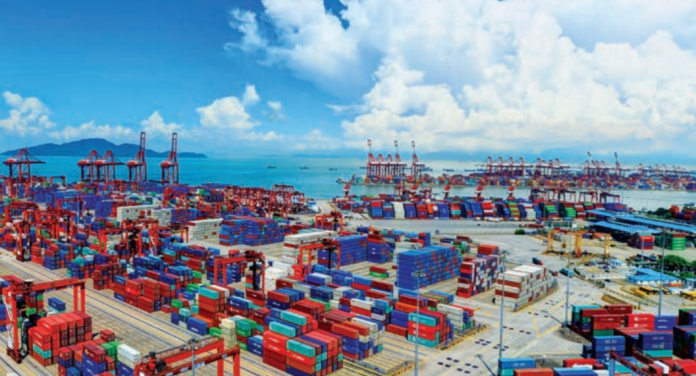The Hong Kong based port and shipping conglomerate China Merchants Port (CMP) Group has said its 5G-enabled port transformation project with Huawei, Alibaba and Tencent at the Haixing (Mawan) port at the mouth of the Pearl River in Shenzhen, in China, is in test mode, and “progressing as planned”.
The work on the Mawan Smart Port, previously known as the Haixing Intelligent Port, represents the first upgrade in China of a traditional sea port to an automated smart port. CMP provided an update, during its latest interim results, to cover off its main elements, which include deployment of a new 5G network with Huawei, plus cloud and edge compute facilities with Alibaba and Tencent. Shenzhen is Huawei’s hometown.
It also weaves in a blockchain-based ledger system for port trade, a high-precision Beidou-based satellite positioning, automated port vehicles and machinery, plus sundry applications for ‘smart customs’, electronic systems, and green and low-carbon energy. De rigeur analytics based artificial intelligence (AI) systems will be deployed, as standard. The entire port setup will be based on CMP’s own CMCore operating system.
Seatrade Maritime News quoted CMP, that the initiative will establish a “model for the smart upgrading of traditional docks at home and abroad”. The Mawan Smart Port is CMP showcase and smart centre for future intelligent ports. The company said in its results missive: “New digitalisation and ‘intelligentisation’ (sic) technology will also open up new roads leading to a world-class port.”
In tandem, CMP said the new Smart Bulk Terminal project at Zhanjiang Port, a natural deep-water harbour in Southeast China, is also on track. Under the guidance of CMP, Zhanjiang Port Group wants the first intelligent bulk cargo terminal in China, integrating IT and OT (information and operation tech), to automate ship loaders and unloaders, and belt and transportation systems.
CMP said: “The group [has] initiated the ‘smart management platform’ project [that] will provide all-rounded empowerment of intelligence in terms of operation, management and control, monitoring, decision-making and service provision, with a view to enhancing the group’s intelligent management comprehensively.
It added: “The Group has attached importance to the strategic cooperation with leading enterprises in the Internet sector, such as Alibaba and Tencent, with which it has signed the strategic cooperation framework agreement, with a view to building a digitalised ecosystem of ports and logistics in collaborative efforts.”
Huawei, meanwhile, is involved variously in China’s port upgrades. Notably, it is engaged with Accenture in the Port of Shanghai, via the Shanghai International Port Group (SIPG), to deploy an enterprise private cloud, based on Oracle software and its own FusionCloud solution, to help SIPG “embark on intelligent operation”.
Huawei said: “With a legacy of complex, dispersed port services, SIPG required a centralised service management solution. The solution was an ERP platform based on a Huawei private cloud. Virtual resource pools form a cloud management platform that allocates resources in a unified and flexible way. Application systems are built, deployed, and configured centrally. Software and hardware that were once scattered are now integrated for unified operations and management. This has enabled SIPG to reduce costs and carbon footprint while improving resource utilization.”
CMP said container throughput volume rose by 0.6 percent year-on-year to 54.87 million twenty-foot equivalent units (TEUs), during the first six months of 2020, despite the impact of the global coronavirus pandemic. Bulk cargo volumes were down by 10.9 percent in the period to 199 million tonnes. Revenue was HK$4,077 million, down by 8.7 percent.

